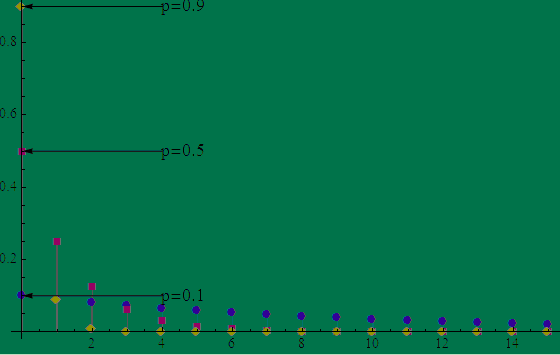博文
The Geometric Probability Distribution(几何分布)
|||
A Geometric experiment possesses the following properties:
1. The experiment consists of a series of identical trials.
2. Each trial results in one of two outcomes: success, S, or failure, F.
3. The probability of success on a single trial is equal to some value p and remains the same from trial
1. The experiment consists of a series of identical trials.
2. Each trial results in one of two outcomes: success, S, or failure, F.
3. The probability of success on a single trial is equal to some value p and remains the same from trial
to trial. The probability of a failure is equal to q = (1 − p).
4. The trials are independent.
5. The random variable of interest is Y , the number of failures before a success occurs.
4. The trials are independent.
5. The random variable of interest is Y , the number of failures before a success occurs.
Definition:
A random variable Y is said to have a geometric probability distribution if and only if
$$p(y) = {\left( {1 - p} \right)^{y}}p,\;\;\;\;y = 0,\;1,\;...,\;0 \le p \le 1.$$
You can use the following Mathematica command to obtain the probability
PDF[GeometricDistribution[p], y]
Relative Mathematica Functions
GeometricDistribution[p] represents a geometric distribution with success probability p.
Examples:
A = GeometricDistribution[p];
a := {Arrowheads[0.02], Arrow[{{4, PDF[A, 0]}, {0, PDF[A, 0]}}]};
t := Text[Style["p=" <> ToString[p], Medium], {4, PDF[A, 0]}, {-1, 0}];
epilog = Table[{a, t}, {p, {0.1, 0.5, 0.9}}];
DiscretePlot[Evaluate@Table[PDF[A,k], {p, {0.1, 0.5, 0.9}}], {k, 0, 15},
PlotRange -> All, PlotMarkers -> Automatic, Epilog -> epilog,
Background -> RGBColor[0.1, 0.45, 0.3, 0.9]]
a := {Arrowheads[0.02], Arrow[{{4, PDF[A, 0]}, {0, PDF[A, 0]}}]};
t := Text[Style["p=" <> ToString[p], Medium], {4, PDF[A, 0]}, {-1, 0}];
epilog = Table[{a, t}, {p, {0.1, 0.5, 0.9}}];
DiscretePlot[Evaluate@Table[PDF[A,k], {p, {0.1, 0.5, 0.9}}], {k, 0, 15},
PlotRange -> All, PlotMarkers -> Automatic, Epilog -> epilog,
Background -> RGBColor[0.1, 0.45, 0.3, 0.9]]
https://blog.sciencenet.cn/blog-531885-597408.html
上一篇:The Binomial Probability Distribution(二项分布)
下一篇:The Negative Binomial Probability Distribution(负二项分布)
